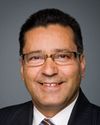Thank you, Mr. Chair, and distinguished members of this committee.
My name is Jean-François LaRue and I am the Director General of the Labour Market Integration Directorate, within the Skills and Employment Branch of Human Resources and Skills Development Canada. I am accompanied by Mr. Jonathan Wells who is the Director of Operations.
On behalf of the Department of Human Resources and Skills Development, I would like to extend my thanks to the committee for the opportunity to contribute to your study on foreign credential recognition.
This afternoon I would like to provide the committee with a brief overview of the important work that HRSDC's foreign credential recognition program, or FCRP, has been doing to improve the labour market outcomes of foreign trained individuals. In doing so I will focus on the implementation of the pan-Canadian framework and describe some of the areas where we've seen significant progress.
The process for the recognition of credentials is complex, costly, and lengthy, with nearly 500 regulatory bodies in Canada, five recognized credential assessment agencies—and there are even more—and numerous professional associations, post-secondary and vocational institutions, and employers throughout 13 jurisdictions. This complex environment ultimately means that many internationally trained workers are often working in survival jobs and not necessarily in jobs commensurate with their skills and experience.
To address these issues, first ministers agreed to take concerted action by tasking labour market ministers to develop a pan-Canadian framework for the assessment and recognition of foreign qualifications.
Launched in 2009 and led by HRSDC, the framework is a public commitment that establishes a shared national vision and guiding principles to improve the labour market integration of internationally trained workers. Through the framework, regulators and stakeholders are working with governments to ensure that the processes used to asses foreign qualifications adhere to the framework's principles of fairness, consistency, transparency, and timeliness.
Given the broad scope of the work, governments agreed to target two sets of priority occupations—and 14 in total—over three years for individual and collective actions. Among others, targeted occupations include engineers, nurses, dentists, and physicians.
Through national consultation, we're proud to acknowledge that regulatory authorities for the first set of eight target occupations are currently meeting the pan-Canadian commitment to timely service. This means that internationally trained individuals in these occupations are informed within one year whether their qualifications will be recognized, whether they need to meet additional requirements necessary for registration, or whether they may consider a related occupation commensurate with their skills and experience.
We should take a moment here to note that, although FCR is largely an area of provincial and territorial jurisdiction, the federal government is playing a leadership and facilitative role by working closely with provincial and territorial governments to implement the framework. To do this, we've taken a number of concrete actions, such as building capacity among provincial and territorial governments, supporting stakeholders through projects that improve FCR processes, facilitating national coordination among key players, and helping individuals with information and targeted financial support.
Fundamental to these efforts is the close relationship that has been developed with our federal counterparts, Citizenship and Immigration Canada and Health Canada. HRSDC's role focuses on overcoming systemic barriers, meaning we work with the stakeholders to foster the development of nationally consistent FCR tools and approaches.
I will let my colleagues from the other two departments explain their role themselves, but there is quite a basic distinction here: the Department of Human Resources and Skills Development works mainly with Canadian systems to attempt to correct the problems that exist.
The framework is being delivered through HRSDC's foreign credential recognition program. The program has also been providing since 2003 strategic financial support to key stakeholders, such as regulatory authorities, to enable them to develop processes and practices that are consistent with the principles of the pan-Canadian framework.
The program has played an important role in facilitating the emergence of pan-Canadian partnerships. Since its inception, the FCR Program has funded 160 projects worth more than $90 million, including seven provincial and territorial agreements to fund the creation of systems and tools to recognize foreign credentials.
For instance, with assistance from the FCR program, the Canadian Dental Regulatory Authorities Federation is implementing a national process for the assessment of foreign credentials whereby internationally trained dentists, if successful in the assessment, will be eligible to take the national exam without additional skills upgrading. This is quite a change from the past, when the answer was usually to go back to a formal training program of two years. This is quite a departure and quite an achievement.
The program has also supported numerous sector councils to enable employers to assess the tools they need facilitate FCR. Our partnership with BioTalent is one such success story.
BioTalent Canada is working to connect internationally trained individuals with potential employers. It works closely with industry to identify the specific essential skills and competencies required in Canada's bio-economy, which also includes the field of medical laboratory sciences. Through the BioSkills recognition program, immigrants or Canadians educated abroad who are found ineligible for certification as medical laboratory technologists have the opportunity to put their skills to use in a related field. This type of project provides internationally trained individuals with alternative career opportunities that appropriately reflect their skills and experience.
Since the beginning of my remarks, I have underlined the expression “internationally trained individuals”, which also covers Canadians educated abroad who may return to Canada for employment.
Furthermore, the FCR program is funding partners to reduce barriers faced by Canadians as they move across provinces and by internationally trained workers who are trying to integrate into the Canadian economy.
Recent improvements to the Agreement on Internal Trade state that workers certified for a regulated occupation in one province or territory can, upon application, be certified for that occupation anywhere in Canada without any additional material training, experience or assessments. As a result, skilled immigrants and all Canadians are able to access opportunities across the country.
In our discussion with various stakeholders, we often heard about the financial difficulties that foreign-trained workers face when seeking to have their credentials recognized. This is a particular challenge for them because their lack of Canadian credit history and work experience can discourage Canadian financial institutions from providing them with loans. Recognizing this, the federal government introduced in Budget 2011 a complementary financial assistance pilot project initiative proposing to help foreign trained workers cover the costs associated with the FCR process.
In summary, national consultations with stakeholders validated that not only are systems for assessment and recognition of foreign credentials complex, lengthy, and costly, but also that those organizations responsible for these systems have a limited capacity on top of daily business to address these issues in their entirety. Common key messages delivered at these meetings identified a need for more pre-arrival supports, more competency-based assessment tools, sustainable and accessible bridging programs, increased availability of supervised work placement, and financial support for individuals and employers.
As I outlined a few moments ago, significant work has already been undertaken, but continued support is required. To maintain the momentum, all governments and key stakeholders—that is, all of the players that we have on the ice—must commit to ongoing collaboration, build upon successes and lessons learned, and continue to take concerted actions beyond 2012.
Clearly, we think we have the right approach. It is critical, I insist, that we continue building on the key partnerships that we have developed with all priority occupations. This is the key to our long-term success going forward.
Thank you, Mr. Chairman.












